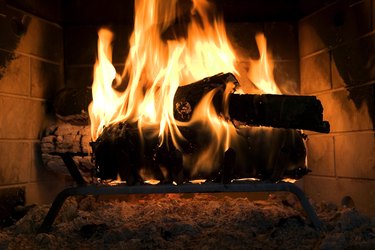
A wood-burning fireplace makes a room cozy and warm. Favored for its woodsy fragrance and dancing flames, a wood fire brings the outdoors to the fireplace. Well-seasoned wood saves energy by radiating heat from the fireplace while using a grate in your fireplace circulates air around firewood for a clean, energy-efficient fire.
Fire Starter
Video of the Day
A fire needs starter, such as newspaper and dry kindling, as a fire foundation. When you crumple newspaper under a grate and crisscross kindling and dry branches on the grate, you have an easy fire built with good air feed. Light a match to the newspaper under the grate, and the fire starts quickly, heating the chimney flue so that wood smoke flows up the chimney. A cold chimney allows outside air to force smoke back into the room. Because air circulates under and around the grate, kindling burns cleaner and faster, heating the cold air in the fireplace and chimney.
Video of the Day
Fire Building Materials
Seasoned firewood provides a good steady burn. Softwoods such as conifers make good kindling, but they burn out quickly and provide little heat value. Stack split hardwood, such as hickory or oak, on the kindling so that the hot kindling heats and ignites the slower-burning hardwood. Building your fire on the grate encourages good airflow around the kindling and hardwood. When the logs rest directly on the fireplace floor, they do not heat evenly as wood resting on the floor is slow to heat and ignite. Wood smokes when it does not get good airflow and smolders instead of burning clean, which reduces heat output and contributes to chimney creosote.
Grates
Grates raise fuel wood off the floor and allow air circulation for better combustion. Fireplace grates range from simple cast iron or steel platforms to complex wood-stacking pipe designs. A grate fits inside the fireplace with about 3 inches between the grate and rear wall and up to 6 inches at the ends, allowing fire-tending around the grate. Cast iron or stainless steel grates offer designs from straight racks to fan shapes, flat braces to curved log-cradling grates. Some grates are shaped like spiders for round fireplaces or fire pits. Ember savers are optional heavy screens that fit over the grate, holding fire embers off the floor to keep the fire burning. Ashes and small embers filter down through the ember screens.
Considerations
Choose a heavy-duty grate. Cheap grates soften and melt under a hot fire. Ensure the grate fits inside the fireplace opening so that a spark screen or glass door closes easily over the fireplace. A hot fire creates hot ashes and coals while the ashes under the grate conceal extremely hot embers and wood bits. Use fireplace tools made of steel or other metal to stir ashes and pick up wood pieces around the grate.